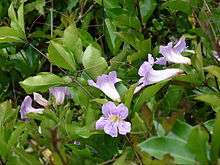Clytostoma
Clytostoma was a genus of woody-stemmed vines from tropical America, native to Argentina and the southern part of Brazil. It is now considered a synonym of Bignonia. The botanical name comes from the Greek, klytos means splendid or beauteous, and stoma means mouth; alluding to the beautiful flowers. It is closely related to Bignonia, from which it differs chiefly in its simple slender tendrils, the short disk, and that it has a habit of clambering over adjacent foliage using tendrils to hang on tight. The bright glossy green leaves are lobed and divided with 2 leaflets, about 3in (7.6 cm) long and 1.5in (3.8 cm) wide. They are arranged opposite in pairs and tendrils arise at the ends of the leaf stalks. In late spring, the spectacular 1.5in (3.8 cm) trumpet flowers are borne terminally or along the branches. The flowers are pale lavender and delicately detailed with dark violet and purple veins. Flowers are followed by large prickly seed pods. This evergreen ornamental plant easily reaches to 16 feet and is a carefree grower. It has only recently been moved out of the genus Pandorea.
| Clytostoma | |
|---|---|
 | |
| Bignonia callistegioides, C. callistegioides may be a synonym[1] | |
| Scientific classification | |
| Kingdom: | |
| (unranked): | |
| (unranked): | |
| (unranked): | |
| Order: | |
| Family: | |
| Genus: | Clytostoma |
| Species | |
|
See text. | |
References
- "Clytostoma callistegioides (Cham.) Baill". The Plant List (2013). Version 1.1. Retrieved 15 February 2015.
- Lord, Tony (2003) Flora : The Gardener's Bible : More than 20,000 garden plants from around the world. London: Cassell. ISBN 0-304-36435-5
- Botanica Sistematica
- plantsystematics.org